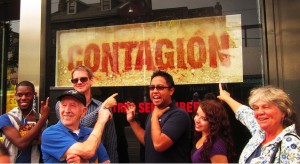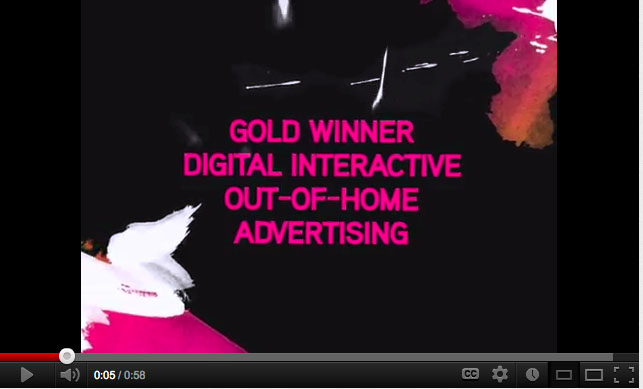“If we want to motivate people to pay attention, we should seize the power of big surprises” (Heath & Heath, 2008, p. 69).
According to the Outdoor Advertising Association of America, over $6.3 Billion dollars are spent on outdoor advertising annually. Out of home advertising has evolved from slapping up an old Billboard on Route 66 to extensive interactive installations conceived and produced to engage viewers as well as entertain or educate them. “In the star-filled universe in which we drift, out-of-home (OOH), is a galaxy unto itself, vast and sprawling” (Sanders, 2012, p.57).
Two advertising campaigns for two recent movie releases recently displayed unique examples for us to consider when thinking about advertising outdoors.
 Photo by Glen D’Souza, Retrieved from http://laughingsquid.com/billboard-grows-bacteria-mold-cultures-to-promote-contagion-movie/
Photo by Glen D’Souza, Retrieved from http://laughingsquid.com/billboard-grows-bacteria-mold-cultures-to-promote-contagion-movie/
The first unique outdoor advertising campaign was a promotional interactive event/installation for the movie Contagion. Advertisers filled a large, empty, rectangular petri dish with various bacteria and mold in the shape of the movie’s moniker, inoculated it, and hung it in a storefront window. Over the next two weeks, passersby were witness to an ever-changing moldscape as the petri dish went from a blank slate to being filled with a living mold in the forming the word Contagion.
The first groups of people to figure out what the words were received free screening tickets or other prizes related to the film. The campaign itself garnered Over 100,000 twitter and Facebook mentions, and over 530,000 Youtube views. The video link below shows how microbiologists and advertisers teamed up to make this one of kind Movie poster made of germs, penicillin and live bacteria.
 www.youtube.com/watch?v=LppK4ZtsDdM
www.youtube.com/watch?v=LppK4ZtsDdM
The second unique outdoor advertising campaign was a promotional interactive event/installation for the movie Coraline. By taking over a vacant storefront and using up to the minute technology, to showcase the film, the advertisers turned unused window fronts into “Storescapes.”
The 3D interactive technology set up in the window and allowed passersby to superimpose their faces into screens with buttons superimposed over their eyes to simulate what it would look like to be a character in the film. This unique campaign drew attention to and created a buzz around the film in a memorable way. The following link shows gives an introduction to the campaign.
http://www.youtube.com/watch?v=A16Fc8a2KkU
With consumers being bombarded by so many messages and advertisements on a day-to-day basis, advertisers and marketers may want to consider using unexpected campaigns like the two referenced above. One piece of advice: if you are thinking of working with live bacteria, don’t forget to put on a Hazmat suit over your thinking cap! Safety first.
References:
Heath, C., & Heath, D., (2008). Made to Stick Why Some Ideas Survive and Others Die (2nd ed.). New York, NY: Random House
Sanders, J., (2012). The Four Dimensions of Out-of Home, The International Journal of Media Marketing, Promotion and Design, 4(1), 56-67
www.curbmedia.com/case-studies-warner.asp

